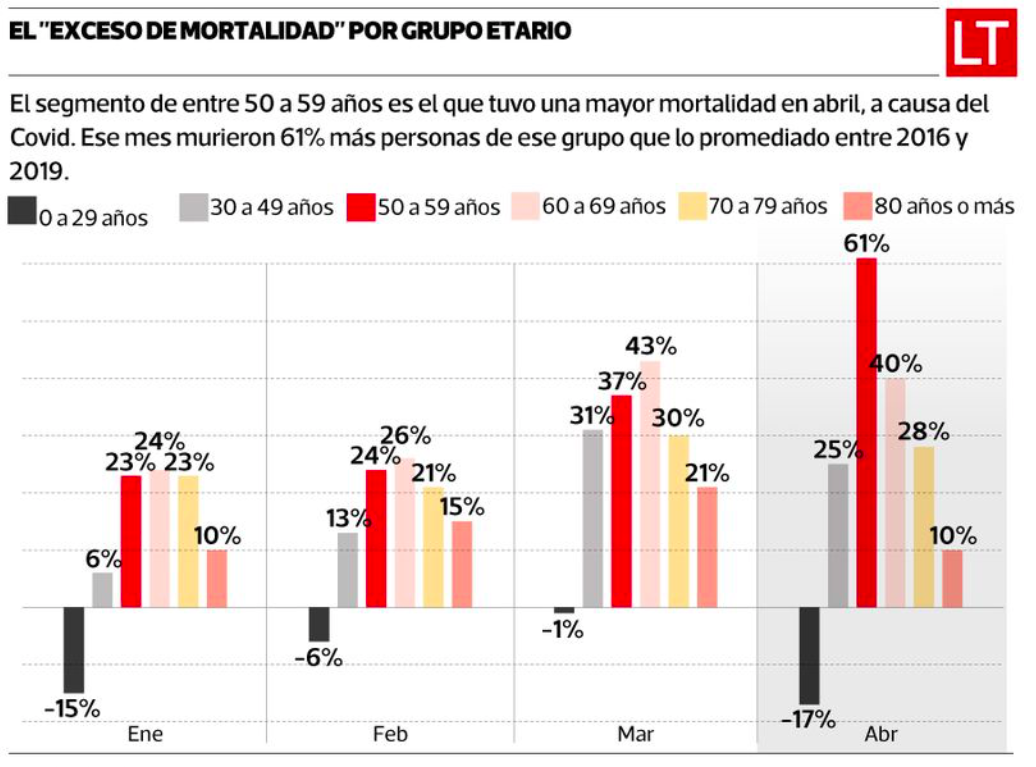RIO DE JANEIRO, BRAZIL – Excess deaths is a health indicator that measures the difference between the number of people who died and the number who would have been expected to die if the pandemic had not occurred.
According to an article by The New York Times, Chile is the third country in the world among a group of more developed nations, with the highest excess of deaths, a ranking headed by Romania, followed by Poland. According to this registry, between 2020 and 2021, the country had 17% more deaths than if it had not experienced the current health crisis. The United States had more of these excess deaths than most other wealthy nations.
Read also: Check out our coverage on Chile
This is the ranking prepared by The New York Times of the percentage of deaths above the usual average (years 2020-2021), using WHO figures for them.
Romania 20%
Poland 19%
Chile 17%
Czech Republic 16%
USA 15%
Italy 12%
UK 12%
Spain 12%
Germany 11%
Netherlands 9%
Portugal 9%
Belgium 8%
Greece 8%
France 7%
Sweden 6%
Canada 4%
South Korea 1%
Japan -1%
Australia -4%
However, the article clarifies that many of the low-income countries “struggled to accurately count pandemic-related deaths,” leading to a global number of excess deaths that is more than double the number of deaths from Covid-19 reported in official calculations worldwide.
According to the registry of the New York newspaper, Chile registered 39,000 deaths due to excess by Covid in these two years.
In wealthier countries, the article says, the gap between reported Covid-19 deaths and estimated total deaths above normal was small, perhaps due to the relatively smaller number of deaths and the existing infrastructure around death notifications.
But among upper-middle-income and low- or lower-middle-income countries, the number of above-normal deaths estimated by the WHO was often many times higher than the number of reported deaths.
These figures, called excess deaths, measure the difference between the number of people who died and the number who would have been expected to die if the pandemic had not happened. The U.S. had more of these excess deaths than most other wealthy nations. https://t.co/JsFwcw4Ymw pic.twitter.com/tYJWSjdgEQ
— The New York Times (@nytimes) May 24, 2022
Around the world, about 13%, or 15 million more people, died than expected in the first two years of the pandemic.
One of the most affected groups was the age segment between 50 and 59 years. In April 2021 alone, this group had an excess mortality of 61%; that is, the death of a person in this age group increased by 61% that month, compared to the months of April between 2016 and 2019. In April of last year, when the pandemic was beginning, the excess mortality of this tranche was 7%.
According to this registry, the group of people aged 60 to 69 had an excess mortality of 40%; the group of 70 to 79 years had an excess of 28%; and the group aged 80 and over had an excess of only 10%. Among the youngest, ages 30 to 49, the excess deaths were 25%.

New estimates from the World Health Organization (WHO) show that the total number of deaths associated directly or indirectly with the Covid-19 pandemic (described as “excess mortality”) between January 1, 2020 and December 31, December 2021 was approximately 14.9 million (range from 13.3 million to 16.6 million), according to a registry of the agency published on May 5.
Excess mortality includes deaths associated with Covid-19 directly (due to the disease) or indirectly (due to the impact of the pandemic on health systems and society). The deaths indirectly linked to Covid-19 are attributable to other health conditions for which people were unable to access prevention and treatment because health systems were overwhelmed by the pandemic. The estimated number of excess mortality may also be influenced by the deaths prevented during the pandemic due to the decreased risk of certain events, such as traffic accidents or work injuries, the agency said in its report.
Most of the excess deaths (84%) are concentrated in Southeast Asia, Europe and the Americas. Around 68% of excess deaths are concentrated in just ten countries globally. Middle-income countries account for 81% of the 14.9 million excess deaths during the 24-month period, while high- and low-income countries each account for 15% and 4%, respectively.
These latest estimates from the WHO are what many scientists say are the most reliable indicator of the full impact of the pandemic.

